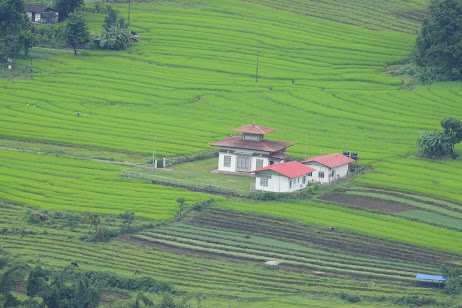The Hindu festival of Dasahara, or Dashain, falls in
the si
Once there was a great king called Dasaratha who ruled
over the kingdom of Ayodhya in the north India. He had three wives (Kausalya,
Kaikayi and Sumitra) and four sons (Rama, Bharata, Lakshmana and Satrughna).
Rama was the son of Kausalya, the eldest queen. He was married to Sita, the
daughter of king Janaka of Mithula. Even as a child, Rama had supernatural
powers. He went to the jungle and killed many demons who were harming holy men.
As time passed, king Dasaratha became old and he
decided to step down from the throne, and to make his eldest son Rama king in his
place. When dasaratha’s second wife, kaikayi, heard that Rama was to become
king, she was very jealous. She wanted her own son, Bharata, to be king.
A long time before, king Dasaratha had made a promise
to Kaikaya to give her whenever she asked, two things she desired most. Now Kaikayi
on remembering the promises kind made, she went to king and asked him to put
her own son Bharata on the throne instead of Rama. She asked him to send Rama
into exile for fourteen years. When the king heard her request, he was
horror-struck. But because of the promise he made, he was forced to do as she
asked.
Rama obeyed his father’s order and went to the forest.
His wife Sita and brother Laxmana went with him. Prince Bharatha himself did
not want to be king. He loved Rama, and thought that Rama would make a better
king than he. Full of sorrow, he followed Rama to the forest, begging him to go
back and rule over Ayodha. But Rama refused, because he had to obey his
father’s command. Bharatha went back and ruled as king, waiting until Rama
should return from exile in fourteen years. King Dasaratha died of sorrow.
In those days, a terrifying ten-headed monster called
Ravana ruled as demon king of Lanka. Ravana heard of Sita’s great beauty, and
decided to take her for himself. He asked his demon friend Maricha to help him.
In the form of a golden deer, Maricha appeared in the forest where Rama, Sita
and Laxmana were staying. Rama and Laxmana went to hunt the deer. When they returned
to their hut, Sita was nowhere to be seen. They travelled from forest to forest
in search of her. On their way, they met a vulture lying on the ground. The
bird told them that Sita had been captured by Ravana.
As Rama and Laxmana continued on their way in search
of Sita, they met with the kings and ministers of the monkeys and bears. One of
the monkey ministers, Hanuman, was a devotee of Rama. Hanuman had magic powers.
He could fly like a bird, and he could make himself as big as a giant, or
smaller then a fly. Hanuman and all the monkeys promised to help Rama get Sita
back. But to reach the kingdom of Lanka and defeat Ravana was not an easy task.
Ravana, the demon king, was very powerful. As a devotee of Lord Shiva, he had
great strength.
He knew the use
of all sorts of magic, besides being a brave and strong warrior, feared by all.
To prepare for his battle with Ravana, Rama performed Pujas and made offerings
to the goddess Durga’s blessing, and defeated and killed Ravana. On that same
day he made Vivishana, Ravana’s brother, king of Lanka. The coronation was
celebrated with ceremonies and teeka.
So lord Rama won victory (Vijaya) over the demon king Ravana. Hindus celebrate this victory
of good over evil in the festival known as Vijaya
Dashamai. The puja of Shakti (power)
is performed, in honour of the goddess Durga.
As lord Rama performed pujas for nine days, and defeated Ravana on the tenth
day, so the present day celebration of Dashain last for ten days. On the first
day, every house hold prepares a sacred Ghata
(pitcher) and start offerings to the goddess Durga. Seeds of wheat and maize are sown. From the tenth day, the
seedlings (jamara) will be offered
with flowers in the teeka ceremony.
From the first day to the ninth day, the Durga puja is performed in nine
different ways. Prasad are
distributed to the family as teeka where
younger people receive Durga’s blessings
from their elders.
The festival is known my many names such as Vijaya Dashami, Durga Puja, Dasahara,
Dashain and Teeka
Compiled by Karma Nidup
(Tshatsip Karma )
Bachelors of Arts in
Language and Literature.
CLCS, Trongsa




